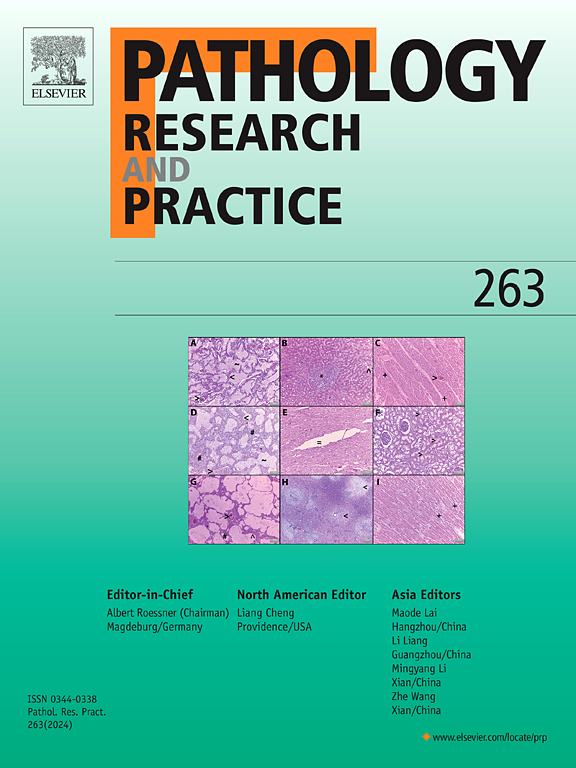Cell lineage-specific immunohistochemical markers in biliary intraepithelial neoplasia: Implications for subclassification and grading
IF 2.9
4区 医学
Q2 PATHOLOGY
引用次数: 0
Abstract
Biliary intraepithelial neoplasia (BilIN), a precursor to cholangiocarcinoma, is categorized into low- and high-grade based on histological characteristics. Although gastric, intestinal, and biliary phenotypes of BilIN have been identified, detailed analyses of their immunophenotypic profiles using cell lineage-specific markers remain limited. This study aimed to define the immunohistochemical profiles of BilIN lesions, subclassify them based on their immunophenotypes, and correlate these profiles with histological grades. We examined 77 BilIN lesions from extrahepatic bile ducts, including 30 low- and 47 high-grade lesions, using immunohistochemical staining for gastric (claudin-18, MUC5AC), intestinal (cadherin-17, glycoprotein A33), and biliary (carbohydrate sulfotransferase 4) markers, along with progression markers (S100P, IMP3). Expression levels were semiquantitatively scored and correlated with histopathological features. BilIN lesions were classified into four immunophenotypes: gastric (G-type), intestinal (I-type), gastrointestinal (GI-type), and biliary (B-type). Low-grade lesions comprised G- (33.3 %), GI- (40 %), I- (13.3 %), and B-types (13.3 %), while high-grade lesions included G- (40.4 %), GI- (29.8 %), I- (21.3 %), and B-types (8.5 %). In low-grade BilIN, G-type lesions corresponded to gastric mucous cells, I-type to intestinal epithelial cells, and B-type to bile duct epithelial cells, while most GI-type lesions exhibited mixed G- and I-type components. High-grade BilIN differentiation based solely on histological characteristics was challenging to delineate due to overlapping features among I-, GI-, and B-type cells. S100P and IMP3 expression levels were significantly elevated in high-grade lesions, particularly within the I+B-type BilIN group, with no notable differences in G- or GI-type BilIN. Immunophenotypic profiling with lineage-specific markers effectively subclassified BilIN, enhancing the understanding of its histogenesis and progression.
求助全文
约1分钟内获得全文
求助全文
来源期刊
CiteScore
5.00
自引率
3.60%
发文量
405
审稿时长
24 days
期刊介绍:
Pathology, Research and Practice provides accessible coverage of the most recent developments across the entire field of pathology: Reviews focus on recent progress in pathology, while Comments look at interesting current problems and at hypotheses for future developments in pathology. Original Papers present novel findings on all aspects of general, anatomic and molecular pathology. Rapid Communications inform readers on preliminary findings that may be relevant for further studies and need to be communicated quickly. Teaching Cases look at new aspects or special diagnostic problems of diseases and at case reports relevant for the pathologist''s practice.

 求助内容:
求助内容: 应助结果提醒方式:
应助结果提醒方式:


